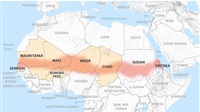Soldiers fell to their deaths as India and China's troops fought with rocks

The hand-to-hand combat lasted hours, on steep,
jagged terrain, with iron bars, rocks and fists. Neither side carried guns.
Most of the soldiers killed in the worst fighting between India and China in 60
years lost their footing or were knocked from the narrow Himalayan ridge,
plunging to their deaths.
India has reacted with shock and caution to the loss
of at least 20 soldiers on its disputed border with China, with images of the
Chinese president, Xi Jinping, burned in Indian cities.
In his first public comments on the dispute, prime
minister Narendra Modi led a two-minute silence for the killed soldiers and
said India would “defend every stone, every inch of its territory.”
“I would like to assure the nation that the
sacrifice of our jawans [troops] will not be in vain,” said Modi, speaking at a
televised meeting of India’s chief ministers. “For us, the unity and
sovereignty of the country is the most important.”
A day after reports of the “violent face-off” in the
western Himalayas emerged, Indian news outlets began naming some of the dead
and a clearer picture started to build of what transpired on Monday night on
the high, steep ridge lines above the fast-flowing Galwan River.
The killings were sparked when a patrol of Indian
soldiers unexpectedly encountered Chinese troops in a steep section of the
mountainous region they believed the People’s Liberation Army had retreated
from, in line with a 6 June disengagement agreement, sources in Delhi said.
The two armies jostled and hand-to-hand fighting
broke out – neither side armed in line with decades of tradition supposed to
ward off the possibility of escalation between the nuclear-armed neighbours.
Then an Indian commanding officer was pushed, fell
from the narrow ridge and fell to his death in the gorge below.
Reinforcements from the Indian side were summoned
from a post about 2 miles away and eventually about 600 men were fighting with
stones, iron rods and other makeshift weapons in near-total darkness for up to
six hours, Indian government sources said, with most deaths on both sides
occurring from soldiers falling or being knocked from mountain terrain.
At least four more Indian soldiers were said to be
in critical condition. Indian media outlets cited intelligence sources claiming
up to 50 Chinese soldiers may have been killed in the melee but did not present
the evidence. Chinese CCTV’s widely watched evening news broadcast made no
mention of the border confrontation on Tuesday.
In a phonecall on Wednesday night between the
Chinese foreign minister, Wang Yi, and India’s minister for external affairs,
Subrahmanyam Jaishankar, the two sides “agreed to deal fairly with the serious
event” and continue with de-escalation, according to a statement by China’s
foreign ministry.
China also reportedly rebuked India, asking the
government to control its troops and punish those responsible for the conflict.
As photos and details of some of the Indian soldiers
who died were circulated on Tuesday there were small demonstrations including
in Bhopal in Madhya Pradesh state and in the Gujarati city Ahmedabad, where
protesters burned pictures of Xi Jinping.
Former Indian army officers argued in fiery television
debates that China had unilaterally changed both the status quo on the border
and the rules of engagement. “Somebody has to answer for 20 lives,” said
retired air vice-marshal Manmohan Bahadur.
But whereas violence in recent years linked to
Pakistan has led to aggressive rhetoric and promises of swift retaliation from
Indian leaders, Monday’s violence has so far drawn a much more muted response
including from Modi.
Analysts said the caution reflected both shock at
the scale of the killing and the complexity of the relationship between the two
Asian giants. “There is the larger picture of the asymmetries of power,” said
Srikanth Kondapalli, a professor of Chinese studies at Jawaharlal Nehru
University in Delhi. “China’s GDP is $14tn, India’s is less than $3tn. China
spends nearly $220bn on the military but India spends $52bn.”
He said Delhi would be considering whether to ask
commanders on the ground to sort out the conflict with their Chinese
counterparts, but would also be under pressure to escalate.
The United Nations, EU and US government have
expressed concern over the violence and urged restraint.
Indian media have reported that talks between
commanders have been held, and high-level Indian officials were meeting at the
ministry of defence, India Today reported.
Both countries’ militaries have blamed the other for
the conflict.
Beijing has refused to confirm any deaths on its
side, but accused India of crossing the border twice and “provoking and
attacking Chinese personnel”.
The editor-in-chief of the state-run the Global
Times, said he understood there had been Chinese casualties, but the People’s
Liberation Army (PLA) wanted to avoid “stoking public mood” by comparing
numbers.
An editorial in the same paper said: “China does not
want to turn border issues with India into a confrontation,” before blaming
India for “arrogance and recklessness”.
Both parties have been working towards de-escalation
in recent weeks but the loss of life makes the situation even more complicated
and precarious.
Chinese state media has reported the PLA is
conducting joint military exercises “aimed at the destruction of key hostile
hubs in a high-elevation mountainous region”. The PLA Tibet Military Command
conducted live fire drills with heavy artillery on Tuesday, with reports
linking the PLA’s preparedness for high-elevation combat to the clashes with
India.







